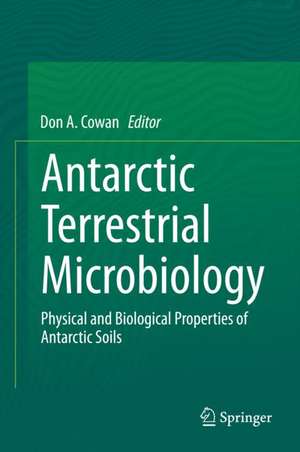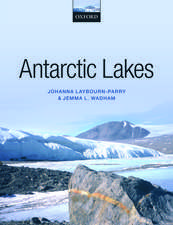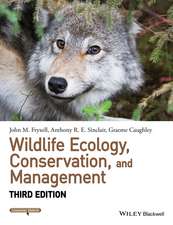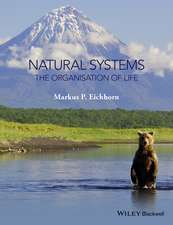Antarctic Terrestrial Microbiology: Physical and Biological Properties of Antarctic Soils
Editat de Don A. Cowanen Limba Engleză Hardback – 25 mar 2014
Antarctic terrestrial soils represent one of the most extreme environments on Earth. Once thought to be largely sterile, it is now known that these diverse and often specialized extreme habitats harbor a very wide range of different microorganisms.
Antarctic soil communities are relatively simple, but not unsophisticated. Recent phylogenetic and microscopic studies have demonstrated that these communities have well established trophic structuring and play a significant role in nutrient cycling in these cold and often dry desert ecosystems. They are surprisingly responsive to change and potentially sensitive to climatic perturbation.
Antarctic terrestrial soils also harbor specialized ‘refuge’habitats, where microbial communities develop under (and within) translucent rocks. These cryptic habitats offer unique models for understanding the physical and biological ‘drivers’ of community development, function and evolution.
| Toate formatele și edițiile | Preț | Express |
|---|---|---|
| Paperback (1) | 946.41 lei 6-8 săpt. | |
| Springer Berlin, Heidelberg – 23 aug 2016 | 946.41 lei 6-8 săpt. | |
| Hardback (1) | 950.52 lei 6-8 săpt. | |
| Springer Berlin, Heidelberg – 25 mar 2014 | 950.52 lei 6-8 săpt. |
Preț: 950.52 lei
Preț vechi: 1159.17 lei
-18% Nou
Puncte Express: 1426
Preț estimativ în valută:
181.90€ • 197.52$ • 152.80£
181.90€ • 197.52$ • 152.80£
Carte tipărită la comandă
Livrare economică 22 aprilie-06 mai
Preluare comenzi: 021 569.72.76
Specificații
ISBN-13: 9783642452123
ISBN-10: 3642452124
Pagini: 328
Ilustrații: VI, 328 p. 62 illus., 47 illus. in color.
Dimensiuni: 155 x 235 x 25 mm
Greutate: 0.59 kg
Ediția:2014
Editura: Springer Berlin, Heidelberg
Colecția Springer
Locul publicării:Berlin, Heidelberg, Germany
ISBN-10: 3642452124
Pagini: 328
Ilustrații: VI, 328 p. 62 illus., 47 illus. in color.
Dimensiuni: 155 x 235 x 25 mm
Greutate: 0.59 kg
Ediția:2014
Editura: Springer Berlin, Heidelberg
Colecția Springer
Locul publicării:Berlin, Heidelberg, Germany
Public țintă
ResearchCuprins
General Introduction.- Bacterial Community Structures of Antarctic Soils.- Fungal Diversity in Antarctic Soils.- Invertebrates.- What Do We Know About Viruses in Terrestrial Antarctica?.- Microbiology of Eutropic Soil.- Fell-field Soil Microbiology.- Biological Soil Crusts.- Lithic Habitats.- Microbial Ecology of Geothermal Habitats in Antarctica.- Microbial life in Antarctic Permafrost Environments.- Primary Production and Links to Carbon Cycling in Antarctic Soils.- Climate Change and Microbial Populations.- Threats to Soil Communities: Human Impacts.- Antarctic Climate and Soils.- Antarctic Soil Properties and Soilscapes.- Origins of Antarctic Soils.
Textul de pe ultima copertă
This book brings together many of the world’s leading experts in the fields of Antarctic terrestrial soil ecology, providing a comprehensive and completely up-to-date analysis of the status of Antarctic soil microbiology.
Antarctic terrestrial soils represent one of the most extreme environments on Earth. Once thought to be largely sterile, it is now known that these diverse and often specialized extreme habitats harbor a very wide range of different microorganisms.
Antarctic soil communities are relatively simple, but not unsophisticated. Recent phylogenetic and microscopic studies have demonstrated that these communities have well established trophic structuring, and play a significant role in nutrient cycling in these cold, and often dry desert ecosystems. They are surprisingly responsive to change, and potentially sensitive to climatic perturbation.
Antarctic terrestrial soils also harbor specialized ‘refuge’habitats, where microbial communities develop under (and within) translucent rocks. These cryptic habitats offer unique models for understanding the physical and biological ‘drivers’ of community development, function and evolution.
Antarctic terrestrial soils represent one of the most extreme environments on Earth. Once thought to be largely sterile, it is now known that these diverse and often specialized extreme habitats harbor a very wide range of different microorganisms.
Antarctic soil communities are relatively simple, but not unsophisticated. Recent phylogenetic and microscopic studies have demonstrated that these communities have well established trophic structuring, and play a significant role in nutrient cycling in these cold, and often dry desert ecosystems. They are surprisingly responsive to change, and potentially sensitive to climatic perturbation.
Antarctic terrestrial soils also harbor specialized ‘refuge’habitats, where microbial communities develop under (and within) translucent rocks. These cryptic habitats offer unique models for understanding the physical and biological ‘drivers’ of community development, function and evolution.
Caracteristici
A timely and comprehensive review of the microbial ecology of one of the world’s most extreme and interesting environments Completely up-to-date Written by the world’s leading experts in the field Includes supplementary material: sn.pub/extras














